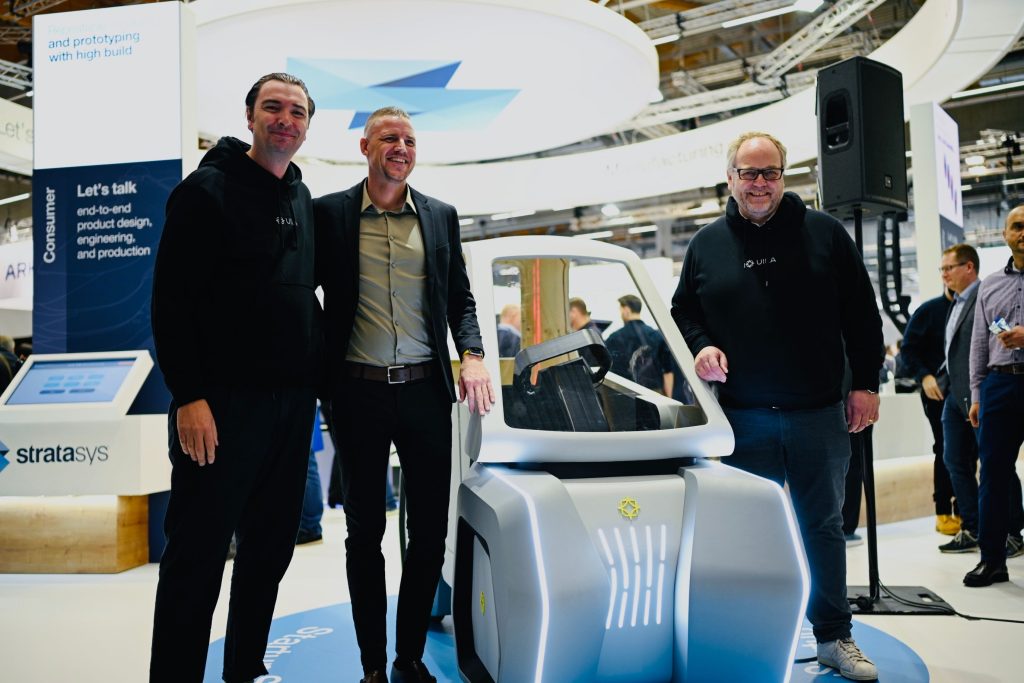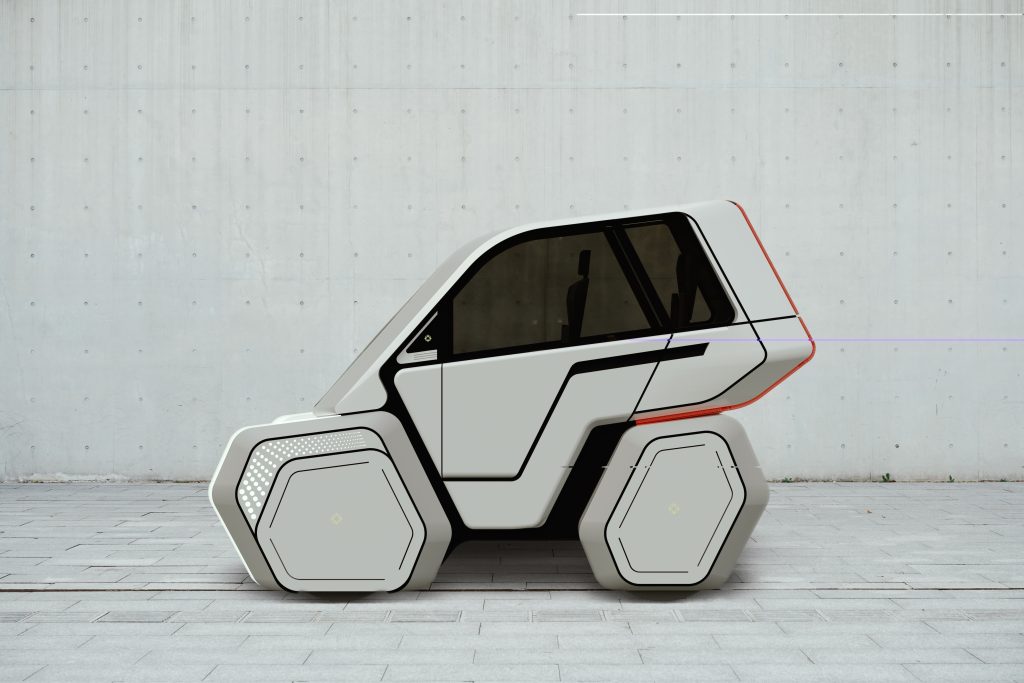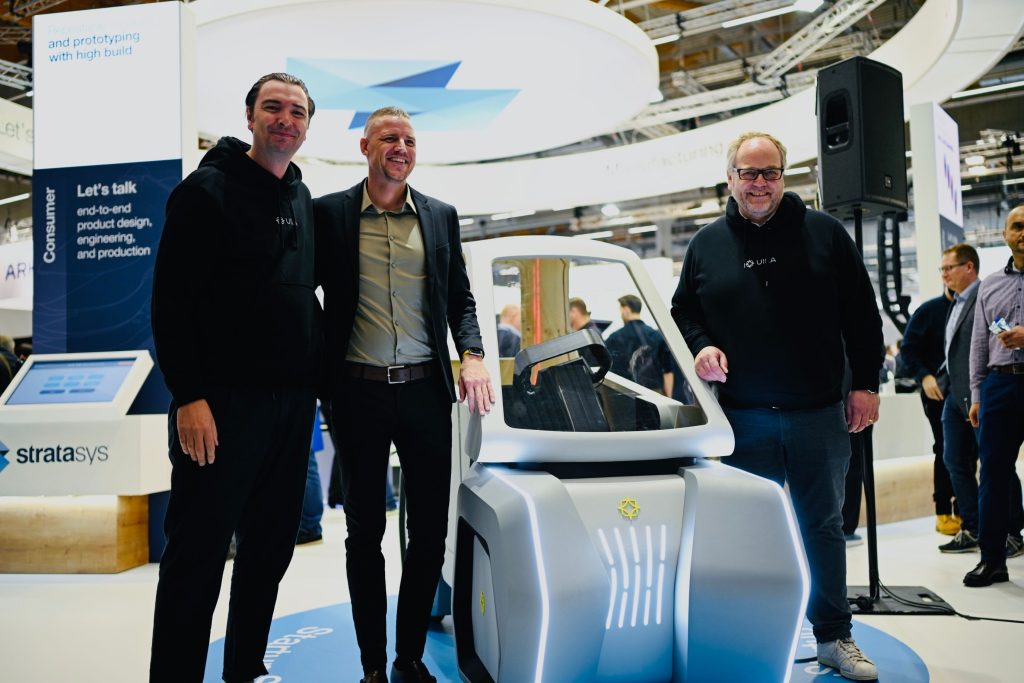The 3D Printing Industry Awards 2022 shortlists are now available for voting. Who will win the 2022 3DPI Awards? Have your say by casting your vote now.
Berlin-based design studio nFrontier has unveiled an innovative new electric vehicle (EV) concept at the Stratasys booth during the Formnext trade show.
Essentially a cross between a cargo bike and a small EV, the four-wheel two-seat UILA is designed to sustainably take passengers and payloads of up to 250 kilos from A to B. Utilizing a combination of different Stratasys technologies, nFrontier says it has been able to build the vehicle in a faster, cheaper and more eco-friendly way than traditional production methods allow.
“UILA is not only radically changing the way we are commuting, but also provides a truly sustainable, game-changing mobility solution. At the same time, it delivers a feature set of digital functions and assets by far exceeding current bicycle industry standards,” said nFrontier CEO Daniel Buening. “We are proud to unveil UILA together with our partner Stratasys. Their technologies have been at the core of our prototype development and will be a key part of our production process.“
“UILA is our response to some of the most pressing challenges of our time such as climate change and the current energy crisis.”

nFrontier’s innovation drive
Named with a nod to U.S. President John F. Kennedy’s famous 1960 “New Frontier” speech, in which he called for technological advancement, the UILA’s creators specialize in creatively applying emerging technologies. Aiming to become one of the leaders in its field, the firm’s facility is equipped with software and hardware supplied by the likes of Stratasys, Franka Emika, Autodesk, Varjo and KeyShot.
With the UILA, New Frontier has attempted to develop an EV that meets the needs of the modern commuter, and addresses the growing clamor for greener solutions in the automotive sector. Citing recent research, the company says that by 2040, more than 750 million electric two and three-wheelers will be on the road. As such, the business sees an “unlimited market” for an eco-friendly alternative.
As the UILA features a pedal-operated drivetrain, it doesn’t require a driving license to take on the road, and it can also be used in bike lanes. In keeping with New Frontier’s modernization objectives, the EV packs an ‘infotainment system’ as well, with a smartphone-driven ‘Follow Me’ functionality, which allows users to summon their parked car so that it drives autonomously towards them.
“UILA is designed to be a digital device featuring many useful digital features that will make driving from A to B more enjoyable,” added nFrontier CVO Dr. Stephan Beyer. “We like to call it an ‘urban device‘ because we believe that these features will unlock UILA’s full potential as a product with a potentially huge impact on urban transportation.”

Showcasing the UILA at Formnext
At Formnext, the UILA’s design was unveiled and explored in greater detail to exhibitors. As it turns out, the vehicle is powered by a chainless electrical drive train, which allows it to effortlessly accelerate to top speeds of 25 km/hr. Measuring 230 cm in length and 90 cm in width, the UILA has a range of 60-70 km and payload capacity of 250 kg, making it suitable for the continuous carrying of large payloads.
Some of the EV’s larger components have been manufactured using Stratasys’ Fused Deposition Modeling (FDM) technology. By deploying FDM instead of traditional manufacturing methods like injection molding, nFrontier says it has been able to create these in-house, in a way that reduced their lead times and secured their supply.
The company has also utilized Stratasys’ higher-volume machines, like its powder-based Selective Absorption Fusion (SAF) offering and Origin One 3D printers, in other parts of the UILA’s build. In doing so, the firm says it has not only driven down costs, but improved the vehicle’s sustainability, by printing fewer parts and using less material, while eliminating emissions that would’ve been caused by shipping.
nFrontier boasts that it has “renowned engineering and manufacturing partners on board,” as it prepares the UILA for serial production and traffic registration in Germany during 2024. For those at Formnext in-person, the EV is on display in hall 12.1, booth D121.

3D printing in the EV revolution
With the world increasingly turning to greener modes of transport, 3D printing has become an attractive way for EV manufacturers to bring design concepts into reality. Back in 2020, the Rinspeed MetroSnap EV concept was unveiled at CES Las Vegas, complete with more than 30 interior and exterior parts made utilizing Stratasys 3D printing.
One of the best-known of these vehicles, the Olli autonomous shuttle, sadly ceased production last year. Built in part using a Cincinnati Incorporated Big Area Additive Manufacturing (BAAM) 3D printer, the Olli featured 360° LiDAR scanners, allowing it to sense its surroundings in all directions and navigate independently.
Elsewhere, the likes of Sakuu’s 3D printed EV batteries are well on their way to commercialization. Earlier this year, the company reached a new milestone in the development of its lithium metal battery, achieving a benchmark energy density of 800 Wh/L, and it now aims to ship even higher-density devices in 2023.
Follow this link for all the Formnext 2022 news.
To stay up to date with the latest 3D printing news, don’t forget to subscribe to the 3D Printing Industry newsletter or follow us on Twitter or liking our page on Facebook.
While you’re here, why not subscribe to our Youtube channel? featuring discussion, debriefs, video shorts and webinar replays.
Are you looking for a job in the additive manufacturing industry? Visit 3D Printing Jobs for a selection of roles in the industry.
Featured image shows the UILA EV being unveiled at Formnext. Photo via nFrontier.
